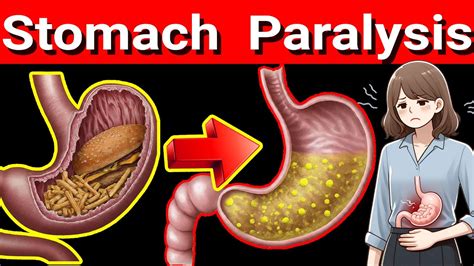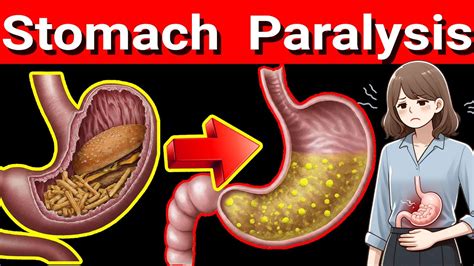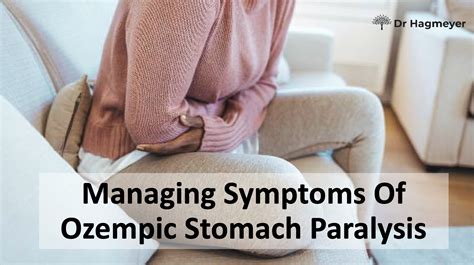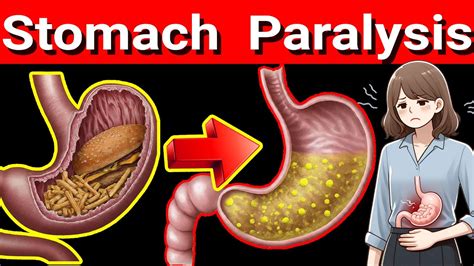Intro
Discover 7 stomach paralysis symptoms, including nausea, vomiting, and abdominal pain. Learn about gastroparesis causes, diagnosis, and treatment options for this digestive disorder, and manage its effects on gut health and overall well-being.
The stomach is a vital organ that plays a crucial role in the digestive system. It is responsible for breaking down food into smaller molecules that can be absorbed by the body. However, there are times when the stomach can become paralyzed, leading to a range of symptoms that can be uncomfortable and even life-threatening. Stomach paralysis, also known as gastroparesis, is a condition where the stomach muscles are weakened, causing food to stay in the stomach for too long. This can lead to a range of symptoms, including nausea, vomiting, and abdominal pain.
Stomach paralysis can be caused by a range of factors, including diabetes, certain medications, and surgery. It can also be caused by viral infections, such as gastroenteritis, and bacterial infections, such as food poisoning. In some cases, the cause of stomach paralysis may be unknown. Regardless of the cause, it is essential to recognize the symptoms of stomach paralysis and seek medical attention if they persist. Untreated stomach paralysis can lead to malnutrition, dehydration, and even organ failure.
The symptoms of stomach paralysis can vary from person to person, but there are some common signs that may indicate that something is wrong. These symptoms can include nausea and vomiting, abdominal pain and bloating, and feeling full after eating only a small amount of food. Other symptoms may include weight loss, fatigue, and abdominal distension. If you are experiencing any of these symptoms, it is essential to seek medical attention to determine the underlying cause and develop a treatment plan.
Understanding Stomach Paralysis

Causes of Stomach Paralysis
Stomach paralysis can be caused by a range of factors, including: * Diabetes: High blood sugar levels can damage the nerves that control the stomach muscles, leading to stomach paralysis. * Certain medications: Some medications, such as narcotics and antidepressants, can slow down the movement of food through the digestive system, leading to stomach paralysis. * Surgery: Surgery on the stomach or surrounding areas can damage the nerves that control the stomach muscles, leading to stomach paralysis. * Viral infections: Viral infections, such as gastroenteritis, can cause inflammation and damage to the stomach muscles, leading to stomach paralysis. * Bacterial infections: Bacterial infections, such as food poisoning, can cause inflammation and damage to the stomach muscles, leading to stomach paralysis.7 Stomach Paralysis Symptoms

Treatment Options for Stomach Paralysis
Treatment for stomach paralysis depends on the underlying cause of the condition. In some cases, medication may be prescribed to help manage symptoms, such as nausea and vomiting. In other cases, dietary changes may be recommended to help manage symptoms. In severe cases, surgery may be necessary to repair any damage to the stomach muscles or surrounding areas.Managing Stomach Paralysis

Complications of Stomach Paralysis
If left untreated, stomach paralysis can lead to a range of complications, including: * Malnutrition: If the stomach is not emptying properly, it can lead to malnutrition and weight loss. * Dehydration: Vomiting and diarrhea can lead to dehydration, which can be life-threatening if left untreated. * Organ failure: In severe cases, stomach paralysis can lead to organ failure, including kidney failure and respiratory failure.Preventing Stomach Paralysis

Seeking Medical Attention
If you are experiencing symptoms of stomach paralysis, it is essential to seek medical attention to determine the underlying cause and develop a treatment plan. A healthcare provider can perform a range of tests, including imaging studies and blood tests, to diagnose stomach paralysis and develop a treatment plan.What is stomach paralysis?
+Stomach paralysis, also known as gastroparesis, is a condition where the stomach muscles are weakened, causing food to stay in the stomach for too long.
What are the symptoms of stomach paralysis?
+The symptoms of stomach paralysis can include nausea and vomiting, abdominal pain and bloating, and feeling full after eating only a small amount of food.
How is stomach paralysis treated?
+Treatment for stomach paralysis depends on the underlying cause of the condition and may include medication, dietary changes, and lifestyle modifications.
Can stomach paralysis be prevented?
+Yes, stomach paralysis can be prevented by eating a healthy, balanced diet, avoiding fatty or high-fiber foods, and getting regular exercise.
What are the complications of stomach paralysis?
+If left untreated, stomach paralysis can lead to a range of complications, including malnutrition, dehydration, and organ failure.
In conclusion, stomach paralysis is a serious condition that requires medical attention to determine the underlying cause and develop a treatment plan. By understanding the symptoms, causes, and treatment options for stomach paralysis, individuals can take steps to manage their symptoms and improve their overall health. If you are experiencing symptoms of stomach paralysis, do not hesitate to seek medical attention. Share this article with others to help raise awareness about stomach paralysis and its importance. Comment below with any questions or concerns you may have, and we will do our best to provide you with the information you need.
